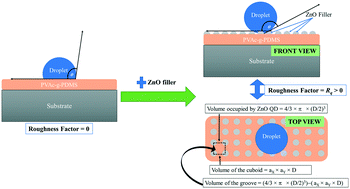A multi-scale modeling and simulation study to investigate the effect of roughness of a surface on its self-cleaning performance†
Abstract
The importance of surface roughness on wettability is vital in developing novel techniques and materials for fabrication of self-cleaning coatings. In this study, the effect of varying roughness of a surface on its wettability was explored through changing the interspacing (ai) and particle diameter (D) of ZnO agglomerated particles in poly(vinylacetate)-graft-poly(dimethylsiloxane) based coatings by constructing and simulating different atomistic and mesoscopic models. The surface roughness has been characterized in terms of roughness factor (Rq = D/ai). Compared to the base matrix, a maximum enhancement in fluid phobicity was observed to be 33% and 172% against water and oil for Rq = 0.9. The surface energy increased moderately (∼21%) and interaction energy against an Al substrate significantly (∼1251%) by a 15 wt% filler incorporation. The investigation reveals that both ai and filler concentration (thereby Rq) control imbibition of water/oil molecules by surface grooves to ensure limited wettability and useful self-cleaning ability. Specifically, optimal surface roughness is achieved at a critical Rq = 0.9 when the ZnO filler interspacing is neither too low for it to act as a continuous surface itself nor too high to allow easy penetration of fluid inside surface grooves.



 Please wait while we load your content...
Please wait while we load your content...